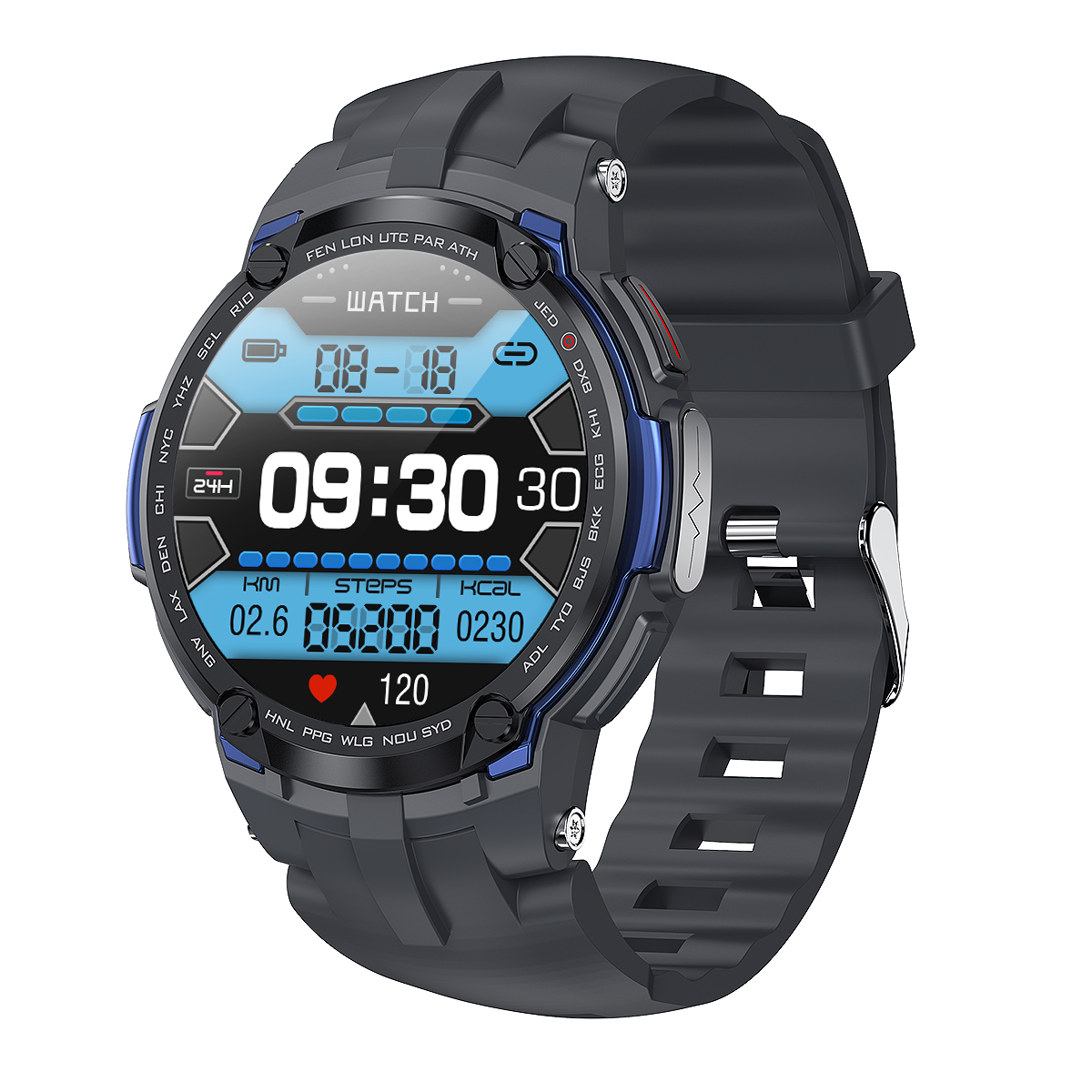Welcome to the official website of Shenzhen Yinsu Intelligent Technology Co., Ltd.
National Service Hotline:+8618927439160 / +86-755-84118220
The Tianjin University team developed the first water-soluble smart watch, and there will be new breakthroughs in the future
- Time of issue:2021-08-25
The Tianjin University team developed the first water-soluble smart watch, and there will be new breakthroughs in the future
(Summary description)As we all know, the medals of the Tokyo Olympics are made of "junk".
The trash here does not refer to the trash that smells odorous and the small bugs flying around, but refers to some industrial or civil electrical and electronic equipment that has been scrapped and no longer used, such as discarded mobile phones, refrigerators and other "electronic waste."
- Time of issue:2021-08-25
As we all know, the medals of the Tokyo Olympics are made from "junk".
The trash here does not refer to the trash that smells odorous and the small bugs flying around, but refers to some industrial or civilian use that has been scrapped and no longer used. Electronic and electrical equipment, such as discarded mobile phones, refrigerators, etc. “electronic waste”.
According to Japanese officials, for the sake of environmental protection, they began to recycle their own electronic waste as early as 2017. In the end, from 80,000 tons of old home appliances and 6.2 million 32 kilograms of gold, 3.5 tons of silver and 2.2 tons of brass were extracted from the old mobile phone.
In recent years, with the rapid development of electronic technology, global consumer electronics sales have shown an explosive growth trend, reaching 103.2 million U.S. dollars in 2019. More than 53.6 million tons of electronic waste.
The subsequent recycling of consumer electronic products has become a thorny issue. In the recycling process of electronic products, a large number of electronic products have undergone rough and Over-simplified processing, such as manual dismantling, open burning, and acid leaching, has produced harmful substances such as PCBs, polybrominated biphenyls, polyvinyl chloride, lead, cadmium, and mercury, causing serious environmental pollution and health problems.
Recently, based on the concept of “environmental protection and easy recycling of electronic products,“ A room temperature water sintered nanocomposite material that can be used for the lead interconnection of dissolvable consumer electronic products, and developed the world's first dissolvable smart watch.
This watch is the same as a traditional smart watch. It has sensors that can accurately measure heart rate, blood oxygen level and step count, and transmit these data to the mobile phone application via Bluetooth connection; the organic light-emitting diode (OLED) screen can also display the date, time and message of the relevant mobile phone, as well as monitoring The wearer’s vital signs and other data.
Picture|Support caller ID
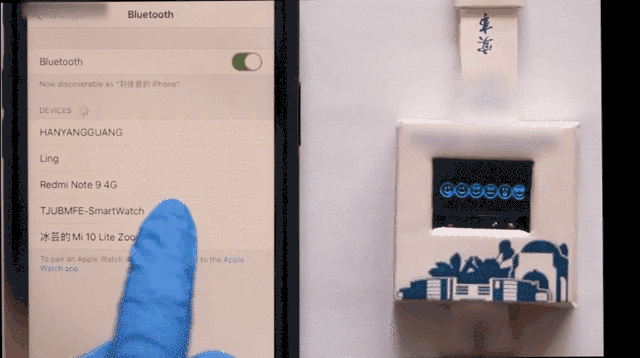
Figure|Support Bluetooth connection
Related research papers titled “Water-Sintered Transient Nanocomposites Used as Electrical Interconnects for Dissolvable Consumer Electronics” were published in “ACS Applied Materials & Interfaces” superior. Professor Huang Xian is the corresponding author of the paper.

Source: ACS Applied Materials & Interfaces
In this regard, Professor Huang Xian’s team told academic headlines that the solution they proposed can achieve rapid recycling of electronic products without pollution, and only need to waste Electronic products can be degraded within a few days after being thrown into water, and the chips and other components in them can still be recycled, which has no pollution and can increase the utilization rate of electronic components.
The first dissolvable electronic watch “Past and Present”
In fact, the world’s first dissolvable smartwatch that we have seen is a transient electronic device.
What is a transient electronic device? What is its significance for environmental protection?
In 2012, in the "A Physically Transient Form of Silicon Electronics" paper published by John Rogers et al. State-of-the-art electronic devices” this new concept.
Transient electronic devices refer to when electronic functional devices achieve a specified function or complete a certain task, their physical form and function can be triggered by external stimuli, An electronic device that partially self-destructs or disappears completely.
Based on the above definition, scientists believe that transient electronic products should have the following three characteristics:
- It has the same stability and reliability as traditional electronic products;
- Realize the transient characteristics of various function conversions;
- The service life is preset and controllable in real time.
Currently, most transient conductive inks require light pulses or laser sintering to improve the conductivity of the ink, but these methods require expensive equipment and harsh Sintering environment.
In order to solve this problem, Professor Huang Xian’s team introduced acid anhydride into the ink to achieve the water sintering of the ink at room temperature. This breakthrough greatly reduced the sintering cost.
Specifically, they used the characteristics of acid anhydride to produce weak acid in water, combined with the effects of local electrochemical corrosion and saturated metal ion redeposition to achieve silver-zinc nanocomposites After gentle sintering at room temperature, the sintered transient electronically soluble material maintains the conductive properties comparable to conventional silver conductive materials.
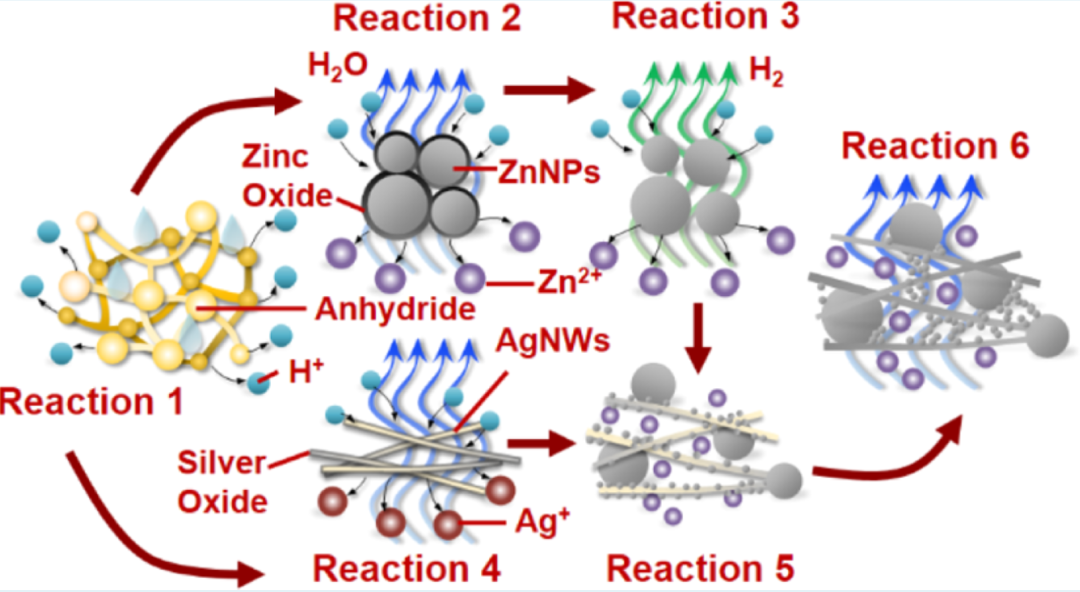
Picture|Sintering mechanism: Acid anhydride produces a weak acid in contact with water, combined with local electrochemical corrosion and saturated ion redeposition effect to achieve sintering of nanocomposite materials. Source: The paper
Moreover, in previous studies, the circuits printed by screen printing are single-sided printing, and the functions implemented are relatively simple, while for smart watches In other words, the use of single-sided printing will severely limit the routing design of interconnect leads, and cannot achieve more functions in a limited space.
In response to this problem, Professor Huang Xian’s team realized for the first time double-sided printing on a biodegradable substrate, ensuring the accuracy of the position through calibration symbols. A drilling machine is used to punch through holes on the substrate, and ink is dripped in the through holes to realize the interconnection of the double-sided leads, which greatly reduces the occupied space.
Based on the above work, the researchers created a smart watch with multiple silver-zinc nanocomposites in a 3D printed biodegradable polymer box, and With printed circuit board.
So far, the first transient consumer electronics product “dissolvable electronic watch” has successfully come out.
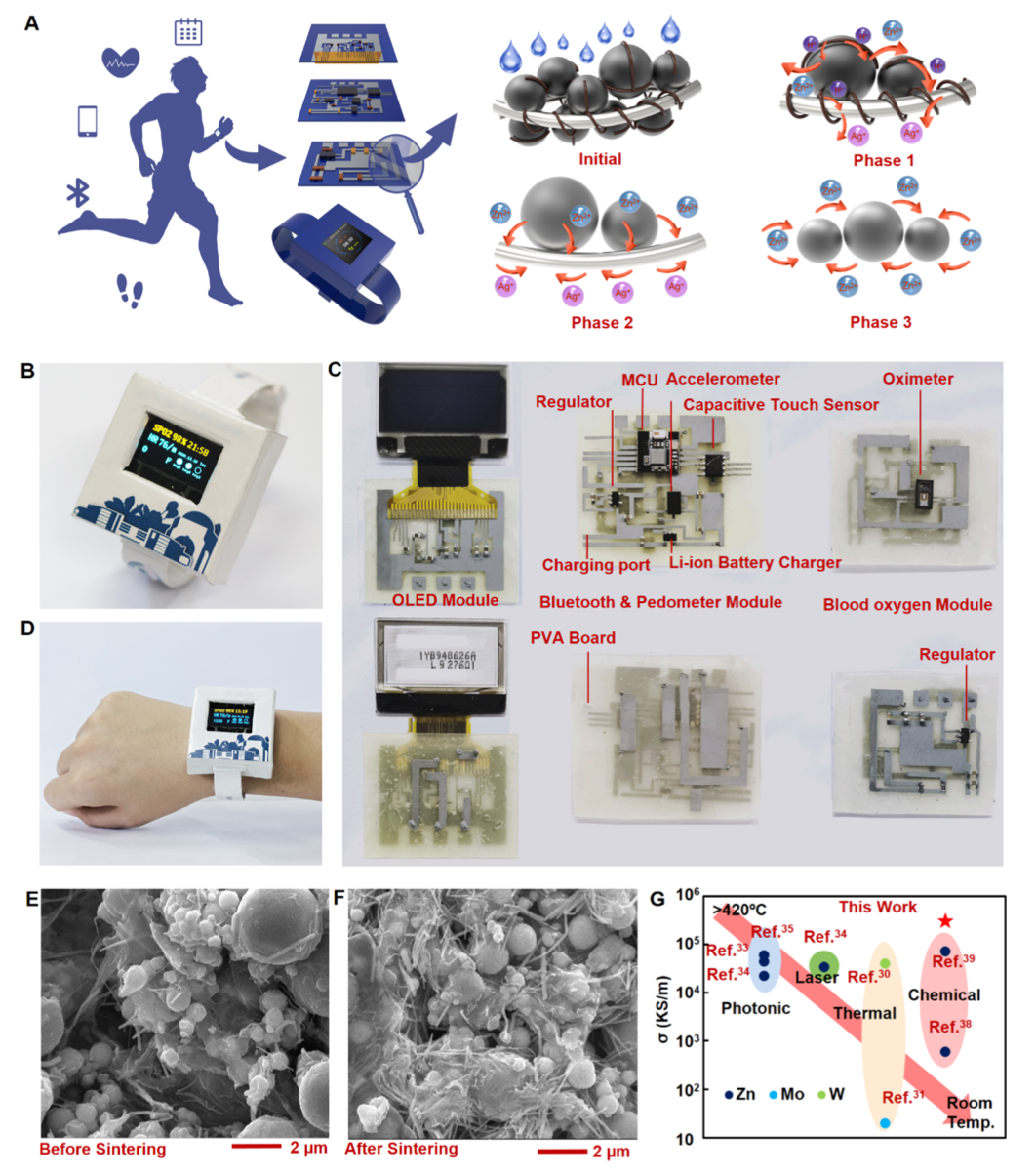
Figure|A. Concept and demonstration of smart watch, schematic diagram of soluble smart watch and water sintering based on bimetal transient nanocomposite; B. Based on bimetal transient A fully printed transient smart watch image of nanocomposite materials; C. Multiple sets of transient printed circuit boards containing different components; D. Smart watch image on the wrist. Source: The paper
“Currently, many studies have shown that metallic zinc is a good transient metal material and bioabsorbable material, and the PVA substrate used is also a good bioavailable material. Absorb organic materials and will not cause damage to the environmentSub-pollution, although there is still a very small amount of silver nanowires in the nanocomposite that cannot be dissolved in water, its content meets the requirements of the Ministry of Ecology and Environment of my country and the safety guidelines issued by the World Health Organization. "Professor Huang Xian's team said.
For the above-mentioned materials for preparing smart watches, Professor Huang Xian’s team stated: “Most biosoluble electronic devices use complementary metal-oxide- Manufactured in semiconductor (CMOS) processes, these processes are very time-consuming and require many special processes. In contrast, devices made with these nanocomposite materials can be mass-produced through printing, cost and energy are much lower, and the output is much higher, which shows that they can easily be incorporated into existing circuit production lines. ”
However, due to the limitation of printing accuracy, the current soluble electronic products are far from mature electronic products on the market in terms of size and comprehensive functions. gap.
“But this research still provides a new idea for solving e-waste in the future. In the future, we will also further optimize the electrical conductivity and printing accuracy of nanocomposites, enrich the functions of the watch, and narrow the gap with mature smart watches. ”
Environmental protection and “gold production”
In this study, when this smartwatch is completely immersed in water, its case and circuit will completely dissolve within 40 hours, and only It is the components of the watch, such as OLED screens and microcontrollers, as well as resistors and capacitors.
In other words, this kind of waste electronic equipment will not need to be recycled by manual dismantling, chemical corrosion, etc., just throw the waste electronic products into the water, that is It can be degraded within a few days, and the chips and other components can still be recycled, which has no pollution and increases the utilization rate of electronic components.
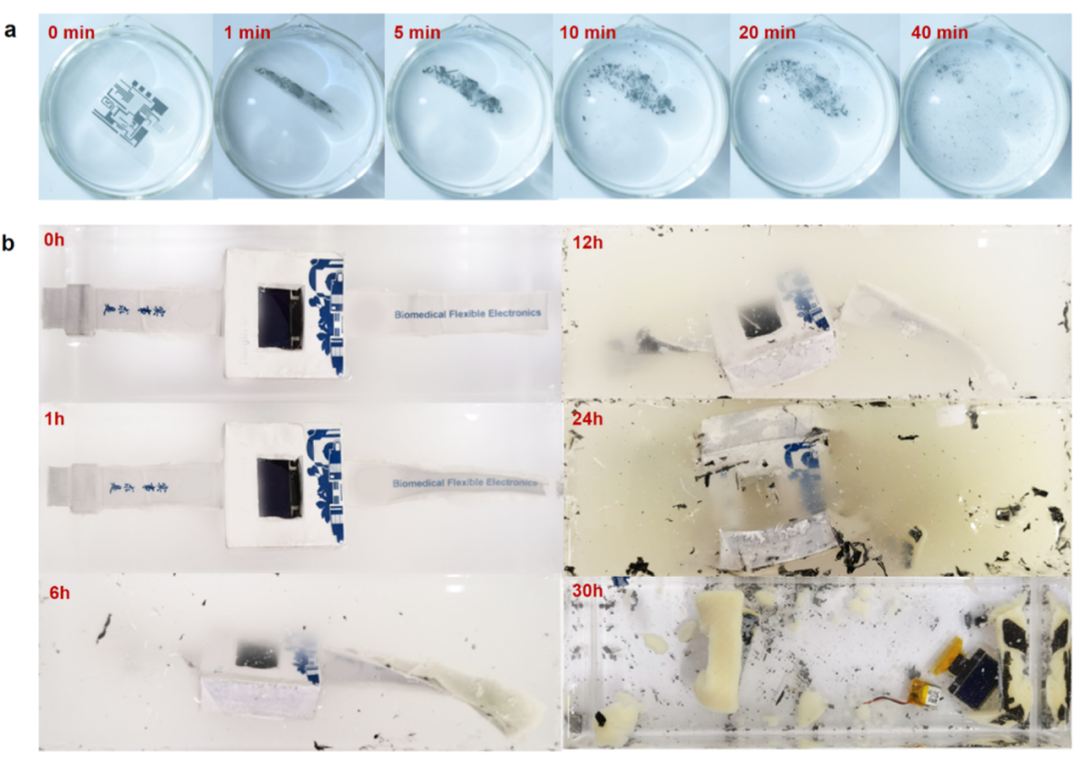
Figure|a. Image of the dissolution process of a transient printed circuit; b. Image of the dissolution process of a smart watch. Source: The paper
But don’t worry, sweat can’t dissolve it.
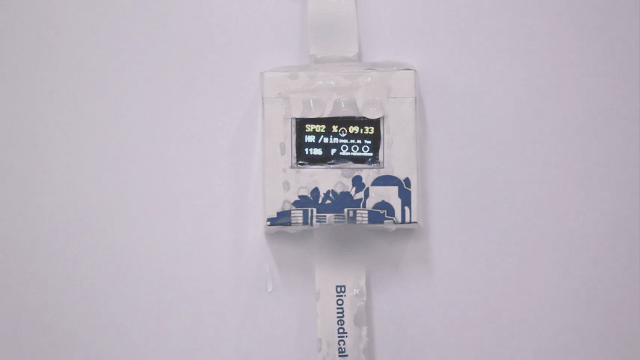
Picture | The smart watch can continue to work without malfunctioning after being exposed to water, which shows that it has a certain tolerance to humidity. Source: The paper
In addition, the significance of this electronic product/component recycling is not only to protect the environment, but also to “produce gold”.
There is a report that the gold content per ton of circuit boards and mobile phones is about 200g and 300g, respectively, while the average grade of gold mines is only 5g per ton. It shows that the gold content of e-waste is 40-60 times that of gold ore. At the same time, electronic waste also contains a large number of other high-value rare metal materials, such as silver, platinum, cobalt, and indium.
However, in the face of e-waste with such a high recycling value, as of 2019, its recycling rate was only 2%. The main reason for the low recycling rate is the high cost of recycling electronic waste and the difficulty of recycling.
Undoubtedly, this soluble electronic product provides a new way to solve e-waste and chip recycling.
In addition, Professor Huang Xian’s team also carried out cytotoxicity experiments on this electronic device material, which proved that the material has good biocompatibility and showed Better electromechanical properties than other biodegradable inks, which means they can be dissolved in the body.
Professor Huang Xian’s team stated that“they may cause printable and implantable devices to disappear into the human body after they complete their functions. "In other words, this kind of electronic equipment is expected to be further used in implantable devices and biomedical applications.
The future can be expected
As early as 2019, Professor Huang Xian’s team successfully developed “water-induced sintering” flexible electronic printing, which is a soluble transient electronic product It has laid the foundation and provided ideas for the development of bio-implantable and degradable devices.
Currently, Professor Huang Xian’s team is carrying out academic-related cooperation with domestic universities, such as the new soluble substrate materials, the transformation of soluble substrates, and various types of soluble The ink mechanism and other aspects.
In addition, Professor Huang Xian’s group revealed to academic headlines that they are currently using ink and sintering technology to prepare various biomedical devices, including assisted wound healing and implantation Type electrochemical measurement device. In the next 3-5 years, the main purpose is to further improve the materials and processing technologies that can be used for the printing of bioabsorbable and degradable devices, improve the printing accuracy and the types of devices that can be prepared, and finally realize a fully soluble complex system.
Reference:
- https://pubs.acs.org/doi/full/10.1021/acsami.1c07102
- https://spectrum.ieee.org/the-world-s-first-dissolvable-smartwatch
- http://bfe.tju.edu.cn/index.html
- https://science.sciencemag.org/content/337/6102/1640
- https://pubs.acs.org/doi/10.1021/acs.chemmater.5b04931
National Service Hotline
+8618927439160
Phone:+8618138419185 / +8618927439160
Tel:+86-755-84118220
Mail:yinsukj@163.com
Address: Room 404, Longsheng Times Building, Gongye West Road, Longsheng Community, Dalang Street, Longhua District, Shenzhen
Official Account

Customer Service







